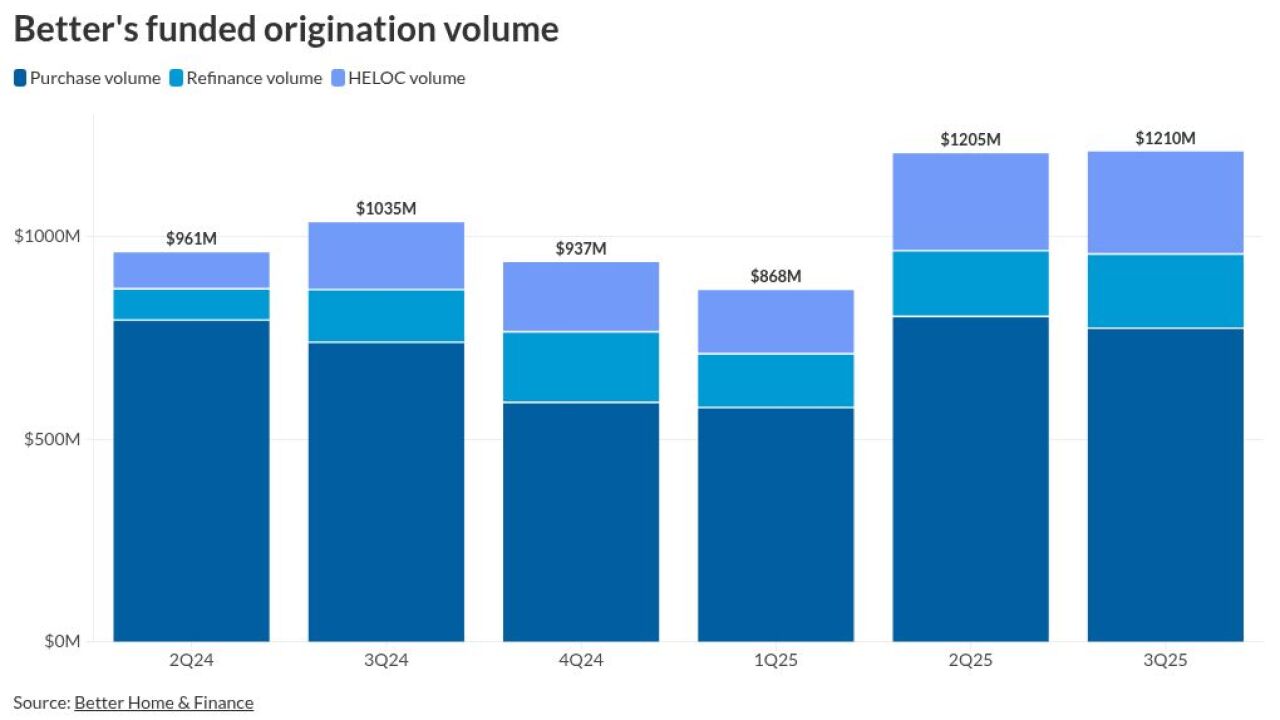
Many components of the capital rules
Trade groups representing banks and various parts of the mortgage industry have come out against the rules, as have housing affordability advocates. These groups say the impact of the proposed rule changes would be felt by the housing sector more so than the banks themselves.
"In the housing sector, which has just been in a sort of boxing ring getting punched, one after another, and getting exhausted from all that's coming at them, this one is pretty incredible," said David Stevens, a long-time mortgage executive who now heads Mountain Lake Consulting in Virginia. "We thought the current Basel rule made sense, but this one's going to have downstream effects that are going to be very broad in the housing system."
The change is
"The big, traditional mortgage lending banks have largely exited the field and that's been going on for some time. This is the next nail in the coffin," said Edward Pinto, director of the AEI Housing Center at the American Enterprise Institute. "This nail will make it harder for banks to compete with Fannie and Freddie, generally, and then take the one market they've had left to themselves, the jumbo market, and make it harder to originate because of the capital requirements."
Some policy experts say the bigger impacts could come from the second-order effects of the regulation. In particular, they point to the treatment of
"With potential borrowers already facing record high interest rates, steep home prices, and supply-chain issues, increased fees and scarcity of bank lenders could be another brick in the wall stopping Americans from obtaining meaningful homeownership and wealth creation," said Andy Duane, a lawyer with mortgage-focused law firm Polunsky Beitel Green.
The proposal, put forth by the Federal Reserve, Federal Deposit Insurance Corp. and Office of the Comptroller on the Currency, notes that the rule change could result in second-order effects on other banks, but it largely focuses on benefits that large banks could enjoy relative to smaller banks as a result of the new rules. It notes that such risks are offset by a requirement that banks adhere to both the new framework and the existing one, to ensure they do not see their regulatory capital levels dip below that of the standardized approach.
Still, the regulators are aware that the change could have unintended consequences on the mortgage industry and housing attainability. Because of this, their proposal includes several questions about the subject.
"We want to ensure that the proposal does not unduly affect mortgage lending, including mortgages to underserved borrowers," Fed Vice Chair for Supervision Michael Barr said while introducing the proposal in an open meeting last month. He added that housing affordability was one of "several areas that I will pay close attention to and encourage thoughtful comments."
However, the proposal dismissed the idea that the new risk weights on residential mortgages would have a material impact on bank lending in that space. Citing various policy papers, academic studies and regulatory reports, the agencies assert that the risk-weight changes would lead banks adjusting their portfolios "only by a few percentage points."
Stevens — who served as an assistant secretary in the Department of Housing and Urban Development in the Obama administration, a commissioner for the Federal Housing Administration and president of the Mortgage Bankers Association — said he is not convinced regulators have done sufficient analysis to rule out the type of sweeping, negative implications that he and others fear. He noted that the 1,087-page proposal includes fewer than 20 pages of economic analysis.
"I just don't think they've thought through the downstream effects and the lack of analysis, in terms of actual financial estimates of the implications, is really concerning," He said. "This will be a really big change, and that's why you see everybody up in arms and the trade groups aligned against this proposal."
Like other components of the bank regulators' Basel III endgame proposal, the components related to mortgages would create standardized capital rules for large banks and do away with the ability for large institutions to use internal models. It also extends these requirements to all banks with more than $100 billion of assets, rather than only the largest, global systemically important banks.
The key provision in the package of proposed rules is the use of loan-to-value, or LTV, ratios to determine risk-weights for residential mortgage exposure.
The change could allow banks to hold less capital against lower LTV mortgages, though there is some skepticism about much of a reduction in capital that change will ultimately entail, especially for GSIBs that previously relied on internal models, said Pete Mills, senior vice president of residential policy for the Mortgage Bankers Association.
"Those risk weights aren't published, so we don't know what they are, but they are probably lower than 50% for low-LTV products," Mills said.
The Basel Committee's latest regulatory accord, which was
Under the current rules, most mortgages in the U.S. are assigned a 50% risk weight, so loans with LTVs between 61% and 80% would see their capital treatment stay the same, and any mortgages with LTVs of 60% or lower would see a lower capital requirement. Loans with an LTV of 80% or higher, meanwhile, would likely see a higher capital requirement.
"For GSIBs, that's probably an increase in capital throughout the LTV rank," Mills said. "For the rest, it's a higher risk weight for higher-LTV mortgages and maybe slightly lower in other bands, but, in aggregate, that's not good for the mortgage market. It's a higher risk weighting for most mortgages."
Approximately 25% of first-lien mortgages held by large banks began with an LTV of 80% or higher, according to data compiled by the Federal Reserve Bank of Philadelphia. Roughly 10% have an LTV of 90% or higher, while half were 70% or lower.
Mark Calabria, former head of the Federal Housing Finance Agency, said he is not surprised by the proposed treatment of mortgages, calling it a "natural evolution" of where regulators have been moving. He added that some elements of the proposal resemble changes he oversaw at Fannie Mae and Freddie Mac in 2020.
Calabria said mortgage risk is an issue in the financial system in need of regulatory reform, but he questions the methods being considered by bank regulators.
"I worry that they're making the problem in the system worse by driving this risk off the balance sheets of depositories, which is probably actually where it should be in the first place," he said. "I'm not opposed to them tinkering in this space they just need to be more holistic about it."
The proposal also notes that the new treatment of residential mortgages is aimed at preventing large banks from having an unfair advantage over smaller competitors.
"Without the adjustment relative to Basel III risk weights in this proposal, marginal funding costs on residential real estate and retail credit exposures for many large banking organizations could have been substantially lower than for smaller organizations not subject to the proposal," the document notes. "Though the larger organizations would have still been subject to higher overall capital requirements, the lower marginal funding costs could have created a competitive disadvantage for smaller firms."
Yet, while regulators say the proposed rules promote a level playing field, some see it giving an unfair advantage to government-backed lenders.
Pinto sees the proposal as a continuation of a decades-long trend of federal regulators putting private lenders at a disadvantage to the governmental and quasi-governmental entities. He noted that if securities from Fannie and Freddie and loans backed by the FHA and Department of Veterans Affairs, which tend to have very high LTVs, are not given the same capital treatment as private-label mortgages, the net result will be the government playing an even larger role in the mortgage market that it already plays.
Pinto said despite these government programs targeting improved affordability, their provision of easy credit only drives up the cost of housing even further. He added that he hopes regulators reverse course on their treatment of mortgages in their final rule.
"They should just back off on this entirely. It's inappropriate," Pinto said. "They need to look at the overall impact they're having on the mortgage market, and the housing and the finance market, and the role of the federal government, and the fact that the federal government is getting larger and larger in its role, which is inappropriate."
The other concern is a lower cap on mortgage servicing assets that can be reflected in a bank's regulatory capital. The proposal would see the cap changed from 25% of Common Equity Tier 1 capital to 10%.
Mills said the capital charge for mortgage servicing rights is already "punitive" at a risk weight of 250%. By lowering the cap, he said, banks will be forced to hold an additional dollar of capital for every dollar of exposure beyond that cap. He noted that regulators had raised the cap to 25% five years ago for banks with between $100 billion and $250 billion of assets to provide some relief to large regional banks interested in that market.
If the cap is lowered, Mills said banks will be inclined to shed assets and shy away from mortgage servicing assets. Such moves would force pricing on servicing rights broadly, a trend that would ultimately lead to higher costs for borrowers.
"MSRs are going to be sold into a less liquid, less deep market, and there are consumer impacts here because MSR premiums are embedded in every mortgage note interest rate," Mills said. "If MSR values are impacted by this significantly, that rolls downhill through the system. An opportunistic buyer might be able to buy rights at a depressed value, but that depressed value flows through to the consumer in the form of a higher interest rate."
The proposal will be open to public comment through the end of November, after which regulators will review the input and incorporate elements of it into a final rule. Between the questions raised in the proposal, the acknowledgement by Fed and FDIC officials that the changes could hurt housing affordability, and the strong negative response to the proposal, there is optimism that the ultimate treatment of residential mortgages will be less impactful.
"Nobody seems to be pushing for this, and nobody other than the Fed seems to like it," Calabria said. "If I was a betting man, it's hard for me to believe that this is finalized the way it is now in terms of mortgages."







